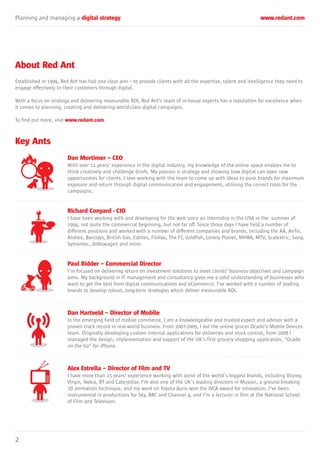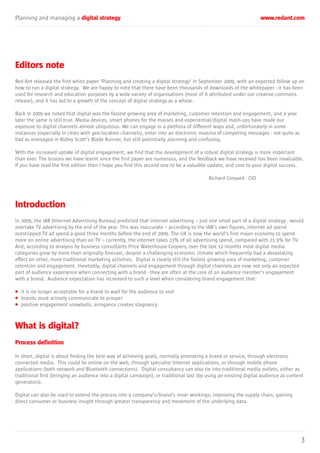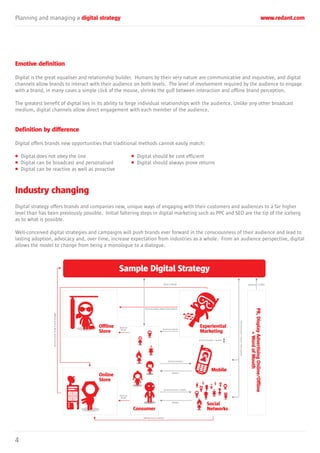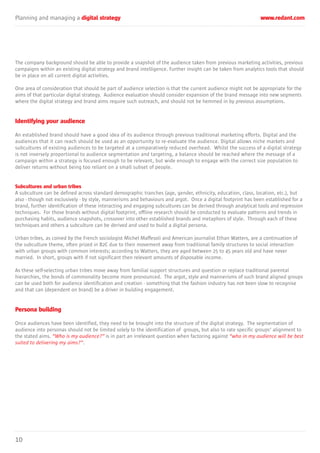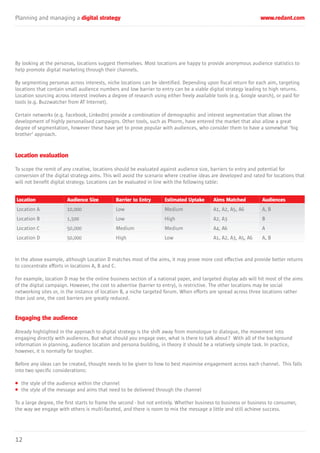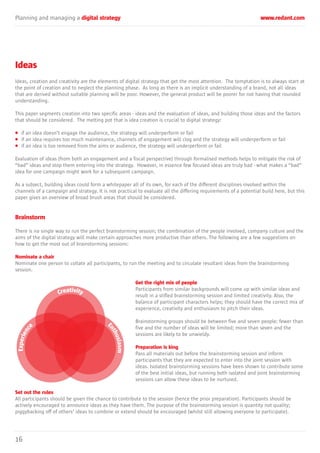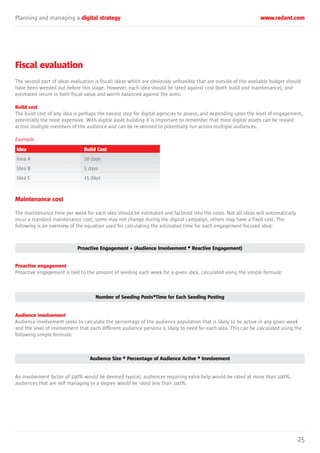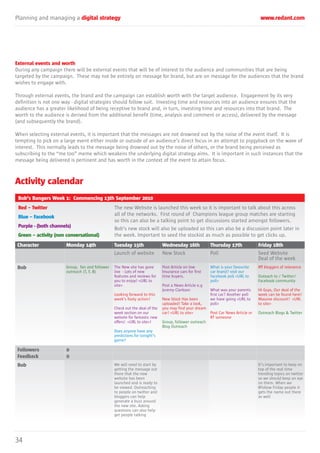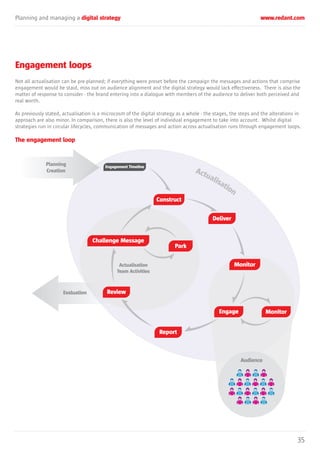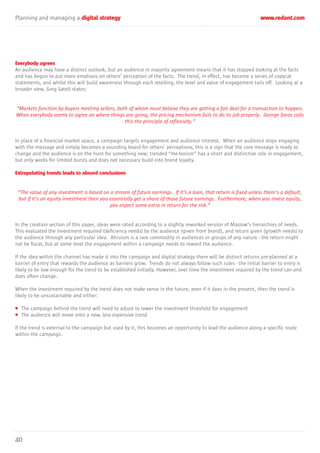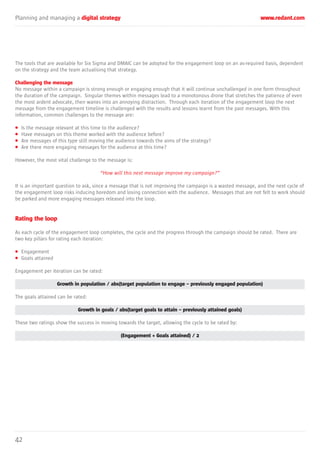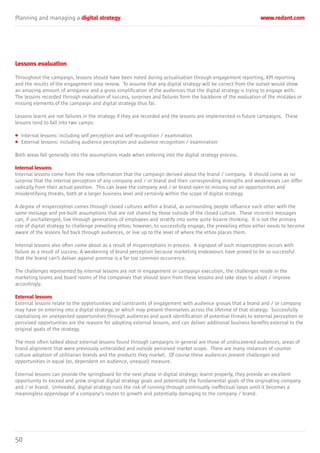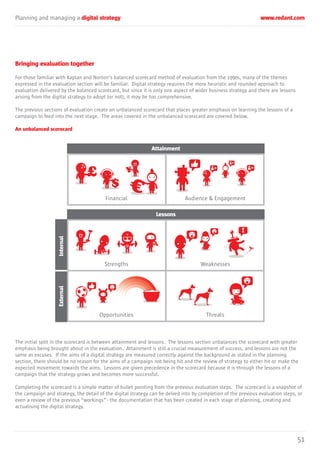Red Ant: Digital Strategy Whitepaper 2011
- 1. planning and managing a digital strategy www.redant.com
- 2. Planning and managing a digital strategy www.redant.com About Red Ant Established in 1999, Red Ant has had one clear aim – to provide clients with all the expertise, talent and intelligence they need to engage effectively to their customers through digital. With a focus on strategy and delivering measurable ROI, Red Ant’s team of in-house experts has a reputation for excellence when it comes to planning, creating and delivering world-class digital campaigns. To find out more, visit www.redant.com Key Ants Dan Mortimer – CEO With over 11 years’ experience in the digital industry, my knowledge of the online space enables me to think creatively and challenge briefs. My passion is strategy and showing how digital can open new opportunities for clients. I love working with the team to come up with ideas to push brands for maximum exposure and return through digital communication and engagement, utilising the correct tools for the campaigns. Richard Conyard - CIO I have been working with and developing for the web since an internship in the USA in the summer of 1994, not quite the commercial beginning, but not far off. Since those days I have held a number of different positions and worked with a number of different companies and brands, including the AA, Airfix, Andrex, Barclays, British Gas, Cattles, Filofax, The FT, Goldfish, Lonely Planet, MHRA, MTV, Scalextric, Sony, Symantec, Volkswagen and more. Paul Bidder – Commercial Director I'm focused on delivering return on investment solutions to meet clients’ business objectives and campaign aims. My background in IT management and consultancy gives me a solid understanding of businesses who want to get the best from digital communications and eCommerce. I’ve worked with a number of leading brands to develop robust, long-term strategies which deliver measurable ROI. Dan Hartveld – Director of Mobile In the emerging field of mobile commerce, I am a knowledgeable and trusted expert and advisor with a proven track record in real-world business. From 2007-2009, I led the online grocer Ocado’s Mobile Devices team. Originally developing custom internal applications for deliveries and stock control, from 2008 I managed the design, implementation and support of the UK's first grocery shopping application, "Ocado on the Go" for iPhone. Alex Estrella – Director of Film and TV I have more than 15 years’ experience working with some of the world's biggest brands, including Disney, Virgin, Nokia, BT and Caterpillar. I’m also one of the UK's leading directors in Musion, a ground-breaking 3D animation technique, and my work on Toyota Auris won the IVCA award for innovation. I’ve been instrumental in productions for Sky, BBC and Channel 4, and I’m a lecturer in film at the National School of Film and Television. 2
- 3. Planning and managing a digital strategy www.redant.com Editors note Red Ant released the first white paper ‘Planning and creating a digital strategy’ in September 2009, with an expected follow up on how to run a digital strategy. We are happy to note that there have been thousands of downloads of the whitepaper - it has been used for research and education purposes by a wide variety of organisations (most of it attributed under our creative commons release), and it has led to a growth of the concept of digital strategy as a whole. Back in 2009 we noted that digital was the fastest growing area of marketing, customer retention and engagement, and a year later the same is still true. Media devices, smart phones for the masses and experiential/digital mash-ups have made our exposure to digital channels almost ubiquitous. We can engage in a plethora of different ways and, unfortunately in some instances (especially in cities with geo-location channels), enter into an electronic miasma of competing messages - not quite as bad as envisaged in Ridley Scott’s Blade Runner, but still potentially alarming and confusing. With the increased uptake of digital engagement, we find that the development of a robust digital strategy is more important than ever. The lessons we have learnt since the first paper are numerous, and the feedback we have received has been invaluable. If you have read the first edition then I hope you find this second one to be a valuable update, and core to your digital success. Richard Conyard - CIO Introduction In 2009, the IAB (Internet Advertising Bureau) predicted that internet advertising – just one small part of a digital strategy - would overtake TV advertising by the end of the year. This was inaccurate – according to the IAB’s own figures, internet ad spend outstripped TV ad spend a good three months before the end of 2009. The UK is now the world’s first major economy to spend more on online advertising than on TV – currently, the internet takes 23% of all advertising spend, compared with 21.9% for TV. And, according to analysis by business consultants Price Waterhouse Coopers, over the last 12 months most digital media categories grew by more than originally forecast, despite a challenging economic climate which frequently had a devastating effect on other, more traditional marketing activities. Digital is clearly still the fastest growing area of marketing, customer retention and engagement. Inevitably, digital channels and engagement through digital channels are now not only an expected part of audience experience when connecting with a brand - they are often at the core of an audience member’s engagement with a brand. Audience expectation has increased to such a level when considering brand engagement that: • it is no longer acceptable for a brand to wait for the audience to visit • brands must actively communicate to prosper • positive engagement snowballs, arrogance creates stagnancy What is digital? Process definition In short, digital is about finding the best way of achieving goals, normally promoting a brand or service, through electronic connected media. This could be online on the web, through specialist Internet applications, or through mobile phone applications (both network and Bluetooth connections). Digital consultancy can also tie into traditional media outlets, either as traditional first (bringing an audience into a digital campaign), or traditional last (by using an existing digital audience as content generators). Digital can also be used to extend the process into a company’s/brand’s inner workings; improving the supply chain, gaining direct consumer or business insight through greater transparency and movement of the underlying data. 3
- 4. Planning and managing a digital strategy www.redant.com Emotive definition Digital is the great equaliser and relationship builder. Humans by their very nature are communicative and inquisitive, and digital channels allow brands to interact with their audience on both levels. The level of involvement required by the audience to engage with a brand, in many cases a simple click of the mouse, shrinks the gulf between interaction and offline brand perception. The greatest benefit of digital lies in its ability to forge individual relationships with the audience. Unlike any other broadcast medium, digital channels allow direct engagement with each member of the audience. Definition by difference Digital offers brands new opportunities that traditional methods cannot easily match: • Digital does not obey the line • Digital should be cost efficient • Digital can be broadcast and personalised • Digital should always prove returns • Digital can be reactive as well as proactive Industry changing Digital strategy offers brands and companies new, unique ways of engaging with their customers and audiences to a far higher level than has been previously possible. Initial faltering steps in digital marketing such as PPC and SEO are the tip of the iceberg as to what is possible. Well-conceived digital strategies and campaigns will push brands ever forward in the consciousness of their audience and lead to lasting adoption, advocacy and, over time, increase expectation from industries as a whole. From an audience perspective, digital allows the model to change from being a monologue to a dialogue. Sample Digital Strategy (Drive to Retail) (Awareness, Traffic) PR, Display Advertising Online/Offline (Communication, Assets, Data Capture) (Affiliate Drive to Retail, Drive to Portal) (Communication + Assets + Data Capture) Offline (Drive to (Communication) Experiential Retail) Store Marketing + Word of Mouth (Communication + Assets) (Communication) (Assets) Mobile Online Store (Communication + Assets) (Drive to Retail) (Assets) Social Consumer Networks (Affiliate Drive to Retail) 4
- 5. Planning and managing a digital strategy www.redant.com Building a digital strategy There are four core stages to building and running a digital strategy: Each of these stages runs into the next to deliver a coherent digital campaign. Combined, they deliver an ongoing digital strategy as the audience and brand perception evolves. Planning Creation Actualisation Evaluation The planning of a digital The creation stage is purely The actualisation focuses on The evaluation of a digital strategy involves analysing focused around campaign the delivery of the campaign, strategy is imperative to learn the following: formalisation. This involves: including: the lessons of the campaign, including: • The initial aims and • Planning campaign • Building the engagement expected returns elements based upon timeline • Evaluating KPIs and fiscal • The background of the previous analysis • Engaging with the achievement brand, present positioning • Creating key performance audience through the • Reviewing engagement and and perception indicators per channel and engagement loop unexpected longer term • The audience (broken down estimating expected return • Sampling progress through benefits into key segments) per channel a campaign and optimising • Taking lessons on board to • Audience locations and • Design and build of the campaign message build stronger future value of each audience campaign elements / • Recording salient campaigns segment against initial channels information through each • Scoring the strategy and aims • Planning and establishing campaign step for the benefits that it has actualisation routes, evaluation given The planning stage deals communication flows and purely in the analysis and expectations The actualisation stage runs Evaluation improves the identification of focus areas. as a microcosm of the effectiveness of future The creation stage for each strategy as a whole and relies campaigns and strategies by channel finishes on the on rapid responses to tune becoming the key building launch of each channel. the strategy. block in planning them. 5
- 6. Planning and managing a digital strategy www.redant.com The lifetime and focus of a digital strategy The lifetime of a digital strategy is a frequently debated subject. Given the different approaches, aims and strategies employed, there is very rarely a ‘one size fits all’ answer to questions concerning the length and lifecycle of the digital strategy. Shiv Singh, Director of digital marketing and social media at PepsiCo, and author of social media marketing for dummies states: “Digital strategy means something that will change my bottom line in 3-6 months.” This has a very definite lifetime. Pushed further, he goes on to explain that the timescales are technology based - so who knows what will be in vogue and / or available technologically six months from now? Whilst Shiv Singh has a point, certainly when it comes to the bottom line, this does pose a further question; should digital strategy be constrained by a technological stand point? The definitions of a digital strategy in this paper, whilst embracing digital as an enabler, do not focus on digital at the centre of the strategy; rather, central to the strategies put forward in this paper is a clear focus on aims and audiences. Caught by the buzz It is all too easy for a digital strategy to get caught in – and be moulded by - the excitement and buzz of a trending technology. Those in digital marketing in 2008 and 2009 were often confronted by the statement: “I would like an iPhone app”. The nature and aims of the app became secondary to an often ill-considered desire to be seen as keeping up with the latest trending technology. For summer 2010 this has changed to: “I would like an iPad app”, still with little thought given to the aims and goals of that app. This approach misses out on some key precepts of digital strategy: • Digital strategy should prove return • Self aggrandisement of a company’s marketing team does not always lead to improved bottom line • The trendiest strategies are not always the best strategies for either audience or aims This paper does not focus on trending technology. Audiences, whether they are businesses or consumers, and their interaction to deliver the aims of the strategy are the most important part, since they contribute directly to the bottom line. Digital lifecycle Digital strategies do not have lifetimes. Campaigns within a digital strategy are likely to have a set lifetime, but the strategy continues with evaluated aims and successes from previous campaigns taken into account and expanded upon. This is why the visual representation of a digital strategy is circular, each campaign building and growing into the next. Businesses and brands keep their core underlying aims for more than the 3 to 6 month window (there are, of course, exceptions). However, by cycling through short campaigns, strategies build and deliver against those aims, ready to move to the next set of brand-based challenges. 6
- 7. share send engage e creat shar e te bora colla collaborate deploy Stage 1: Planning 7
- 8. Planning and managing a digital strategy www.redant.com Aims Aims are the foundation of any digital strategy. They should be generic rather than specific at the planning stage, so as not to overload with detail. The detail behind the aims of a digital strategy will be defined by the digital strategy process. Concentrating on specific aims from the outset runs the risk of missing potential opportunities and channels of a digital strategy. Generic goals normally include increased awareness, building an audience and / or educating that audience, increasing reputation, and ultimately making the conversion. Limitations generally consist of conflict of interest with existing business practices and / or outlets, initial perception (both audience and reputation), and budget. Working with these goals and limitations, digital consultants can start to build clear strategies to meet these aims. Whilst each brand will have its own specific aims and objectives, they can normally be aligned to one of these four main groups: • Consumer awareness and demand creation • Direct consumer drive to retail and purchase • Education and incentive within the retail space • Process improvement through streamlined communications Each of these groups will have mirrored activities offline and it is imperative that any existing brand activities are covered within the background. Positioning aims Aims can be further clarified by ranking against: • Focus: Aims can have a very direct and specific focus that can be achieved in few ways, or a broad focus that can be achieved in many different ways • Process: Aims can require the audience to handle few or many steps (e.g. awareness as opposed to conversion) • Length of engagement: Aims may have a short term turnaround or be long term engagements / relationships Process Awareness Focus Engagement Broad Short Term Engagement Long Term Focus Direct Process Conversion 8
- 9. Planning and managing a digital strategy www.redant.com Sample aims can be seen in the following table: Reference Aim Focus Process Engagement A1 Increased awareness of core brand products Broad Awareness Short term A2 Target audience groups likely to become long term consumers Direct Conversion Medium term with below the line offline promotion A3 Capture details of potential consumers for future campaigns Direct Conversion Medium term A4 Reaffirm core brand message of luxury and quality Broad Awareness Long term A5 Develop an audience around the key message to progress from Direct Conversion Long term influenced to advocates A6 Consolidate current audiences to allow easier message spread Direct Awareness Long term Background Digital strategy cannot live in isolation from the existing activities and history of the brand. Before any meaningful digital strategy can be put in place, the brand must be understood inside and out. Misplaced brand identity within a digital strategy will at best lead to a misfiring campaign - at worst it can lead to long term damage for the brand in question. The message for any digital strategy must be on brand or at least on brand aspirations, as defined in the aims. Whilst a subjective viewpoint is all well and good, living and breathing the brand will open up ideas for digital strategy that will take the brand to the next level. The creative stage and the actualisation stage will require a strong knowledge of offline marketing strategy activities. The most successful strategies have fully integrated digital and offline strands. Understanding the background also helps to expose unrealistic aims and stops the digital strategy promising to deliver more than it is capable of doing. For example, a new product launch without any great seeding budget aiming to become a household name within a few weeks of the strategy commencing is highly unrealistic, regardless of the proposition of the digital campaign. Audience One of the core propositions of modern digital strategies is the Key: role reversal of the audience from being a non-participatory group Seed into an engaged and lively medium through which further brand Influencers advocacy can take place. Working with the brand audience in a positive engagement through digital marketing techniques can Advocates enable brand exposure to snowball, but the flipside to this Influenced proposition is that negative experience is also broadcast to a wider sphere. Audience management is a key factor in the actualisation stage; however, to work with the brand audience the first step must be to identify and understand each of its segments. The diagram to the left shows a simplified message path of a single idea within a digital strategy. The idea is initially seeded through both idea creation and advertising (paid and unpaid). It is likely the idea will be picked up initially (but not exclusively) by existing advocates. Through them, the message will spread to those that will be influenced by the idea, namely further advocates and influencers within the market space. When conducted correctly, this can result in a snowball effect - an influencer aligns with an idea in a strategy and in turn encourages support from their own advocates, who go on to become ambassadors for the idea themselves. 9
- 10. Planning and managing a digital strategy www.redant.com The company background should be able to provide a snapshot of the audience taken from previous marketing activities, previous campaigns within an existing digital strategy and brand intelligence. Further insight can be taken from analytics tools that should be in place on all current digital activities. One area of consideration that should be part of audience selection is that the current audience might not be appropriate for the aims of that particular digital strategy. Audience evaluation should consider expansion of the brand message into new segments where the digital strategy and brand aims require such outreach, and should not be hemmed in by previous assumptions. Identifying your audience An established brand should have a good idea of its audience through previous traditional marketing efforts. Digital and the audiences that it can reach should be used as an opportunity to re-evaluate the audience. Digital allows niche markets and subcultures of existing audiences to be targeted at a comparatively reduced overhead. Whilst the success of a digital strategy is not inversely proportional to audience segmentation and targeting, a balance should be reached where the message of a campaign within a strategy is focused enough to be relevant, but wide enough to engage with the correct size population to deliver returns without being too reliant on a small subset of people. Subcultures and urban tribes A subculture can be defined across standard demographic tranches (age, gender, ethnicity, education, class, location, etc.), but also - though not exclusively - by style, mannerisms and behaviours and argot. Once a digital footprint has been established for a brand, further identification of these interacting and engaging subcultures can be derived through analytical tools and regression techniques. For those brands without digital footprint, offline research should be conducted to evaluate patterns and trends in purchasing habits, audience snapshots, crossover into other established brands and metaphors of style. Through each of these techniques and others a subculture can be derived and used to build a digital persona. Urban tribes, as coined by the French sociologist Michel Maffesoli and American journalist Ethan Watters, are a continuation of the subculture theme, often prized in B2C due to their movement away from traditional family structures to social interaction with urban groups with common interests; according to Watters, they are aged between 25 to 45 years old and have never married. In short, groups with if not significant then relevant amounts of disposable income. As these self-selecting urban tribes move away from familial support structures and question or replace traditional parental hierarchies, the bonds of commonality become more pronounced. The argot, style and mannerisms of such brand aligned groups can be used both for audience identification and creation - something that the fashion industry has not been slow to recognise and that can (dependent on brand) be a driver in building engagement. Persona building Once audiences have been identified, they need to be brought into the structure of the digital strategy. The segmentation of audience into personas should not be limited solely to the identification of groups, but also to rate specific groups’ alignment to the stated aims. “Who is my audience?” is in part an irrelevant question when factoring against “who in my audience will be best suited to delivering my aims?”. 10
- 11. Planning and managing a digital strategy www.redant.com Two sample personas can be seen below: Existing customers ( Audience A) Targeted customers - First time car buyers (Audience B ) • Male/Female 18 to 32 • Male 18 to 24 • Full-time worker • Higher education • Single or married • Single or in a relationship • Technically adept, comfortable online, but not advanced • Technically adept and highly active on social networking sites • Homeowner or renting • Still living at home relation to aims relation to aims • An audience in which to increase awareness, and • An audience in which to tap into and gain Awareness maintain top-of-mind positioning • First time car buyers with low disposable income that will • Most likely to be in the market regardless and as only be able to afford used cars experienced consumers they are looking for the best • Most likely channels are Facebook, Twitter, MySpace, experience at the best cost Google and Autotrader • Most likely channels are LinkedIn, Friends re-united, • Establishing brand relationship at a young audience. business magazines &broadsheet newspapers More likely to return when they are older. Finding your audience One of the benefits of digital strategy is the opportunity to segment activity into different spheres and places directly targeted to the location of the audience - or more specifically the personas matching the aims of the digital strategy. Targeting activities in this way can be used to reduce cost whilst increasing efficiency and message for each of the channels based in these locations. Demographic segmentation location sourcing From each of the personas defined it is possible to apply demographic filters to major locations where digital strategy activities can take place – e.g. social networking sites, blogs, search engines or forums. Often locations are applicable to multiple personas and demographics (e.g. Facebook, which is almost ubiquitous across western consumer audiences). Mobile Internet 657 million* 600 million* 593 million* 530 million* 500 million* Mobile smartphones ebay Facebook Mobile twitter Orkut Friendster LinkedIn MySpace Bebo Blackberry 270 million* 223 million* 150 million* 105 million* 100 million* 75 million* 70 million* 66 million* 52 million* 50 million* Flickr Viadeo iPhone Tablet Devices Xing Ping 40 million* 30 million* 29 million* 19 million* 10 million* 2 million* * Users per month - approximate Figures 11
- 12. Planning and managing a digital strategy www.redant.com By looking at the personas, locations suggest themselves. Most locations are happy to provide anonymous audience statistics to help promote digital marketing through their channels. By segmenting personas across interests, niche locations can be identified. Depending upon fiscal return for each aim, targeting locations that contain small audience numbers and low barrier to entry can be a viable digital strategy leading to high returns. Location sourcing across interest involves a degree of research using either freely available tools (e.g. Google search), or paid for tools (e.g. Buzzwatcher from AT Internet). Certain networks (e.g. Facebook, LinkedIn) provide a combination of demographic and interest segmentation that allows the development of highly personalised campaigns. Other tools, such as Phorm, have entered the market that also allow a great degree of segmentation, however these have yet to prove popular with audiences, who consider them to have a somewhat ‘big brother’ approach. Location evaluation To scope the remit of any creative, locations should be evaluated against audience size, barriers to entry and potential for conversion of the digital strategy aims. This will avoid the scenario where creative ideas are developed and rated for locations that will not benefit digital strategy. Locations can be evaluated in line with the following table: Location Audience Size Barrier to Entry Estimated Uptake Aims Matched Audiences Location A 10,000 Low Medium A1, A2, A5, A6 A, B Location B 1,500 Low High A2, A3 B Location C 50,000 Medium Medium A4, A6 A Location D 50,000 High Low A1, A2, A3, A5, A6 A, B In the above example, although Location D matches most of the aims, it may prove more cost effective and provide better returns to concentrate efforts in locations A, B and C. For example, location D may be the online business section of a national paper, and targeted display ads will hit most of the aims of the digital campaign. However, the cost to advertise (barrier to entry), is restrictive. The other locations may be social networking sites or, in the instance of location B, a niche targeted forum. When efforts are spread across three locations rather than just one, the cost barriers are greatly reduced. Engaging the audience Already highlighted in the approach to digital strategy is the shift away from monologue to dialogue, the movement into engaging directly with audiences. But what should you engage over, what is there to talk about? With all of the background information in planning, audience location and persona building, in theory it should be a relatively simple task. In practice, however, it is normally far tougher. Before any ideas can be created, thought needs to be given to how to best maximise engagement across each channel. This falls into two specific considerations: • the style of the audience within the channel • the style of the message and aims that need to be delivered through the channel To a large degree, the first starts to frame the second - but not entirely. Whether business to business or business to consumer, the way we engage with others is multi-faceted, and there is room to mix the message a little and still achieve success. 12
- 13. Planning and managing a digital strategy www.redant.com Research The easiest step to take in planning how to talk to the audience is to conduct research; how do they currently speak in each of the locations? e.g.: • Tone, phrase and linguistics • What has previously got them talking and where does that align with the digital strategy? • What are competitors doing successfully, and what does not appear to be working? In addition, some research across potential key influencers would highlight common user generated content patterns, e.g.: • How personal is the communication between the members of the audience? • How much do they share (how influential could they be for your campaign)? • What is the common level of engagement? The common goal of the research is to identify what messages have been considered to have worth through each of the locations, and how do audiences communicate that? Social styles – Merrill and Reid Psychologists Merrill and Reid defined a measurement to quantify how people best communicate with their definition of social styles. Built across the axis of assertiveness and responsiveness, the four precepts of social styles and how they group people are: Task Analytical Driver Cool, independent Risk taker Guarded Strong opinions Disciplined about time Takes social initiative Measured opinions and actions Makes statements Use facts Ask Tell Amiable Expressive Supportive Warm, approachable Lets others take social initiative Emotional decision making Moderate opinions Communicative Go along attitude Dramatic opinions and actions Risk avoider Easy to get to know Emotion Audiences fall across different groups which are mediated by persona and by the channels they are using, time of the message / action that is being performed and the experience with the campaign. What is clear from studies by Merrill and Reid is that people tend to engage better within their mix of social styles, and work with those directly adjacent (e.g. ‘amiable’ works with ‘expressive’); however, diagonal competing styles stifle engagement through lack of empathy (e.g. ‘amiable’ is likely to clash with ‘driver’). To achieve aims across the digital strategy, it is likely that people will be involved in each of the four social styles. However, it is exceptionally difficult to engage each of these styles through a single channel and any attempt to do so is likely to result in a mishmash of competing styles that confuse the audience. As each audience member becomes more familiar with the campaign, there will be additional leniency as to what is on and off message (provided that the core message remains). However, competing styles (especially those at the diagonal) will either need to come through different channels or through influencers within a community of practice. 13
- 14. Planning and managing a digital strategy www.redant.com Communication Potential message routes and styles of communication can be brought together to provide a reference framework for the creation of ideas and message, and how they tie back to the aim: Aim Community Persona Locations Social Style Increase Brand Student interest First time car buyers. Facebook fan Trend-setter and Awareness communities. For Low disposable pages, groups and risk taker, with example Student income, 18 – 24, Still Ads. Twitter strong opinions Unions, Student living at home. Uses Student Twibes, and statements. Voucher Pages, Social Networking sites groups and lists. Young and open Student Bars & NUS You Tube pages Planning conclusion At the end of the planning stage of a digital strategy, all concerned should be clear about: • The desired aims of the digital strategy • The audiences each of the aims are targeted at in order to achieve the best results • Where to find each of the audiences to achieve the goals • Best communication methods of engaging with the audience This allows all creativity to be focused directly on achieving the best returns across the digital strategy. 14
- 15. ebsite w main p g & eComameesrc e engine comp & promo site campaign ro promo pages dynamic content c mi redirect campaign front page info pages data capture contact form Stage 2: Creation 15
- 16. Planning and managing a digital strategy www.redant.com Ideas Ideas, creation and creativity are the elements of digital strategy that get the most attention. The temptation is to always start at the point of creation and to neglect the planning phase. As long as there is an implicit understanding of a brand, not all ideas that are derived without suitable planning will be poor. However, the general product will be poorer for not having that rounded understanding. This paper segments creation into two specific areas - ideas and the evaluation of ideas, and building those ideas and the factors that should be considered. The melting pot that is idea creation is crucial to digital strategy: • if an idea doesn’t engage the audience, the strategy will underperform or fail • if an idea requires too much maintenance, channels of engagement will clog and the strategy will underperform or fail • if an idea is too removed from the aims or audience, the strategy will underperform or fail Evaluation of ideas (from both an engagement and a fiscal perspective) through formalised methods helps to mitigate the risk of “bad” ideas and stop them entering into the strategy. However, in essence few focused ideas are truly bad - what makes a “bad” idea for one campaign might work for a subsequent campaign. As a subject, building ideas could form a whitepaper all of its own, for each of the different disciplines involved within the channels of a campaign and strategy. It is not practical to evaluate all the differing requirements of a potential build here, but this paper gives an overview of broad brush areas that should be considered. Brainstorm There is no single way to run the perfect brainstorming session; the combination of the people involved, company culture and the aims of the digital strategy will make certain approaches more productive than others. The following are a few suggestions on how to get the most out of brainstorming sessions: Nominate a chair Nominate one person to collate all participants, to run the meeting and to circulate resultant ideas from the brainstorming session. Get the right mix of people Participants from similar backgrounds will come up with similar ideas and result in a stifled brainstorming session and limited creativity. Also, the balance of participant characters helps; they should have the correct mix of experience, creativity and enthusiasm to pitch their ideas. Brainstorming groups should be between five and seven people: fewer than five and the number of ideas will be limited; more than seven and the sessions are likely to be unwieldy. Preparation is king Pass all materials out before the brainstorming session and inform participants that they are expected to enter into the joint session with ideas. Isolated brainstorming sessions have been shown to contribute some of the best initial ideas, but running both isolated and joint brainstorming sessions can allow these ideas to be nurtured. Set out the rules All participants should be given the chance to contribute to the session (hence the prior preparation). Participants should be actively encouraged to announce ideas as they have them. The purpose of the brainstorming session is quantity not quality; piggybacking off of others’ ideas to combine or extend should be encouraged (whilst still allowing everyone to participate). 16
- 17. Planning and managing a digital strategy www.redant.com No criticism During the ideas gathering stage there are no such things as bad ideas. Criticism encourages participants to retreat from ideas and stifles creativity. Note all ideas down Ideas should be recorded, ideally to a flipchart or whiteboard. This will allow all ideas to be reviewed by all participants. This also shows the ideas route, how they evolved and upon review may result in further combinations and extension of ideas. Once all ideas have been generated, each should be evaluated in terms of brief pros and cons, costs and benefits, feasibility etc. These will determine which ideas are pushed for a formal evaluation against both the merits of the idea and the aims of the digital strategy in terms of engagement and cost. Locations and areas for ideas By the time this paper is released the locations and areas for ideas will already be out of date, given the shifting nature of technology and new opportunities that are open for digital strategy. The following graphic will hopefully inspire some ideas that can be tailored to other digital strategies. Orkut TV Commercials LinkedIn Online Gaming iGoogle Videos/Show-reels TubeMogul Reddit Mobile website Augmented Reality QQ Forums Point of sale Viral Games Offline Facebook Yahoo Google Base Geocaching Email Marketing Foursquare Twitter Blogs Vimeo Website Mobile applications Google Buzz MSN homepage applications Google Reader WiFi / Bluetooth YouTube q q Microsite del.ic.ios PPC Content syndication ebay Spotify MS Live chat QR Codes Banner Ads Viadeo Xing Page TakeOvers Kelkoo Digg Google News Direct Mail SEO 17
- 18. Planning and managing a digital strategy www.redant.com Engagement evaluation There are two parts to the evaluation of any idea to determine whether it should be proposed as a channel for use in a digital strategy. The most obvious is fiscal feasibility, based upon cost and expected return; but it is also important to remember the engagement evaluation. To build a digital strategy there are often multiple composite ideas that form a distinct channel (user journey). Each of these ideas needs to be rated as follows: • How does the idea match the needs of the audience? • Which audience groups does the idea touch upon? • Where do the ideas sit on the engagement path? • How do the ideas interconnect (if required) to route the audience through to the final step of the engagement path? The value of the ideas themselves and a coherent picture of how users move through different ideas in a channel can then be evaluated. Transposing Maslow’s needs hierarchy From his work as a clinical psychologist, Abraham Maslow devised a model for explaining the essential needs for healthy psychological development. Maslow’s hierarchy of needs is used in building motivational routes by a number of different disciplines. Physiological Needs Functional Needs Deficiency Needs Safety Needs Safety Needs Social Needs User Experience Needs Esteem Needs Esteem Needs Growth Needs Self Actualisation Needs Engagement Needs Maslow’s needs hierarchy can be translated into digital terms to rate the engagement of each idea from the brainstorming session. Each particular idea may only reach a certain level within the hierarchy of needs when based against the audience requirement. Deficiency needs Deficiency needs are those that must be satisfied to ensure the idea’s (or individual’s) existence and security. Unless the idea comprises a very small part of a channel, the deficiency needs must be met for the idea to be even moderately successful. Physiological / functional needs Physiological needs are elements such as food, water and air - the most basic of all needs for a human to survive. These have their corresponding needs when evaluating ideas - do they meet the aims or part of the aims of the digital strategy? If these functional needs are unsatisfied, an individual’s actions will be dominated by attempts to fulfil them, opening up a second set of needs or more often than not causing the individual to move on. 18
- 19. Planning and managing a digital strategy www.redant.com An example of a functional need would be having the ability to browse a site created for the campaign, the speed of the site, compatibility with the user’s computer or just plain whether it actually works! Safety needs In Maslow’s hierarchy, these needs relate to obtaining a secure environment in which an individual is free from threats. When transposing these into digital ideas there is a direct parallel in security, but there is also the factor of the barriers to entry to consider. Does the idea make the audience jump through a number of hoops and assumptions before getting to the value? These digital safety needs are most often unmet when the idea is closely aligned to internal brand perception as opposed to the audience. Social / user experience needs Social needs cover friendship and interaction within the physical world. In the digital world these are mirrored initially by user experience, rather than the more obvious parallel of social media networks. This is due to the role of digital and the expectation of the audience. Otherwise, to hit these criteria every idea would have to be deployed through a social media network. The interaction here is between the audience and the idea. Growth needs For Maslow, growth needs are concerned with personal development and realisation of an individual’s potential. Within the digital strategy sphere, the individual is replaced with the aims of the digital strategy and audience progression and / or evolution to these aims. Esteem needs Within Maslow, esteem needs include the desire for achievement, prestige, recognition as well as appreciation and attention from others. Digital ideas can be rated against these (consider the games and quizzes on Facebook) to see what value a member of the audience receives from the effort they will be expected to put in. Self-actualisation / engagement needs This is the ultimate goal - the achievement of complete satisfaction by an individual successfully fulfilling their potential. In digital terms, these are essentially ideas without barriers that allow the audience to move from being inactive participants to influencers, advocates and, physiologically, partners in pushing the digital strategy’s aims. Engagement path Awareness Evaluation Use Conversion Engagement The engagement path shows the steps along the audience’s interaction with a digital strategy. The ultimate aim of a digital strategy should be to move the audience through each step within the engagement path to achieve the stated goals of the digital strategy. Awareness The initial steps involve the audience being aware of the brand and one or more elements of the campaign. A specific idea could be solely focused on stimulating awareness of other elements of the digital strategy, e.g. a PPC advert linking to a microsite. Evaluation Evaluation is the equivalent of dipping a toe in the water. This may involve limited exposure to a further reaching idea, a light weight approach to a deeper idea using progressive disclosure or potentially a walkthrough of a more advanced idea. The evaluation step encourages the audience to move through to the next stage in the engagement path without setting up the barrier to commit. 19
- 20. Planning and managing a digital strategy www.redant.com Use To achieve the aims of the digital strategy, at some point the audience will be expected to use one of the tools within the campaign, hopefully repetitively. Use should not raise the barrier of conversion, e.g. the user being forced to expend excessive time and/or money. Conversion An idea that reaches the conversion stage of the engagement path will be meeting the short term aims of the digital strategy, e.g. making a single purchase through a site. Engagement Engagement involves entering into long term dialogue with the audience over an idea. Ideas that reach the engagement stage can result in repeat conversion and the transition of the audience from being inactive participants to active advocates. Idea and digital channel touch points For each idea there will be a digital channel through which it will be delivered. Not all ideas and channels will touch upon all audiences, and some audiences may be reached by multiple touch points. For a digital strategy to work, however, each audience must have a touch point within reach. Location Examples TV – National and Regional Radio – National and Regional Press – National and Regional Magazines – Targeted Titles Point of Sale – Instore Experiential – Events/Shows Exhibitions – Targeted Titles Mobile Display Advertising Search (Google) Twitter Forum/Blogs Email Social (Facebook/MySpace/Bebo) Video (YouTube) 20
- 21. Planning and managing a digital strategy www.redant.com Engagement evaluation With ideas rated across a digital transposition of Maslow’s needs, their route along the engagement path and their touch points to audience segments established, the following chart can be created: Engagement Conversion Use Evaluation Awareness er og ne te e ite er g itt Si nn Pa gi Bl os Tw En n Ba icr an ai tM ch M n kF ig ar oo uc pa Se od eb m Ca c Pr Fa Examples For each idea, this chart shows: • The highest level attained within the Maslow evaluation (through colour) • The steps along the engagement path that idea achieves • The route a member of the audience might take between ideas to move to the final stages of the engagement path 21
- 22. Planning and managing a digital strategy www.redant.com Channel Approaches Whilst each digital strategy is unique, the first edition of this paper highlighted that some of the concepts and some of the ideas raised were somewhat difficult to follow without example. The following are three small examples of channels of ideas being put together using different tactics to achieve different end goals. Each of these form just a small part of a digital strategy, but should help clarify the concept of a channel and some of the tactics that could be employed. The UGC loop Awareness Drive to Purchase Search Engines A ce n Audie Campaign Site Social Search Campaign Engagement B nce Brand Audie Campaign Page Microsite Display Advertising Brand & Product Info Campaign UGCE Page C nce Audie Mobile Below the Campaign Line Voucher iTunes Prize Draw/ Campaign Engagement Free Sample Shop The User Generated Content (UGC) loop starts with initial seeding to drive initial awareness and subsequently uses user generated content to perpetuate the campaign. Normally tied with a below the line promotion, or self actualising / ego driven competitive element to encourage the audience to participate and become part of the awareness drive of the campaign. Focusing on the initial locations, Facebook helps UGC perpetuation of a campaign by pushing updates, tools and application messages onto the news feeds of connected friends. This has, of course, extended through Facebook social plugins from the confines of Facebook pages to external websites. The microsite in this model becomes the focus of the campaign with the social reach used as an extension of awareness, like a spider at the centre of its web. Dependent on the length of the campaign the microsite may achieve independent awareness through search engines, but over short campaigns social traffic and seeding is likely to be the direct driver. 22
- 23. Planning and managing a digital strategy www.redant.com The digital experiential Brand Ambassador Brand Ambassador Brand Ambassador Virtual Stand / Walled Garden (50 metres) Digital does not have to be limited to websites, mobile app or social media channels. The above example uses digital as an aid to an experiential campaign with brand stand and brand ambassadors. Through use of open wireless networks that brand ambassadors and the public can connect to with mobile devices, the stand and experience are projected over a far wider area. The interaction and engagement would be dependent upon the experience the brand is trying to convey, however, the following have been used: • Walled gardens of mobile website content • Video interactions including augmented reality (both to on-stand screens and to mobile devices) • Real time games and interactions with the audience in the area of coverage • Download of assets for later consumption by the audience • Data captured on iPad / tablet machines Extending the mobile aspect further by using targeted SMS push and / or geo-location social media services (e.g. Foursquare) helps to build awareness and target audience groups that are more likely to engage. The benefit of bringing digital into experiential is that of extending the experience. An audience can be seeded before the event, live interactions can be recorded at the event and through unlocking captured assets over time, the audience can be communicated with after the event. The 5 to 10 minutes of engagement that the brand might usually have is extended over a period of weeks. A simple version of this model was used by Red Ant at Internet World 2010; purposefully run without any form of awareness campaign, engagement with the target audience ran to 18%. 23
- 24. Planning and managing a digital strategy www.redant.com The online and offline – below the line Awareness & below the line competition Awareness Loop (sub competition) New Product Microsite Web Outdoor, DM, In-store, TV, Radio Retailer Website Online Competition Submission Retailer Offline Competition Retailer Submission Store Offline - Awareness & below the line competition Digital strategy does not have to focus purely on digital devices and on digital feedback. In many instances there is a direct requirement in the aims, or good reason from the background to the strategy to work from an offline first step, and potentially deliver direct offline aims. This model uses both an initial seed from an offline promotion and in store conversion allowing the entire campaign, from an audience perspective, to be conducted offline should they so choose. The DM affords the opportunity to push the digital touch points for the brand and campaign to drive awareness so that in the future the audience can be engaged with through digital, which will reduce costs. 24
- 25. Planning and managing a digital strategy www.redant.com Fiscal evaluation The second part of ideas evaluation is fiscal; ideas which are obviously unfeasible that are outside of the available budget should have been weeded out before this stage. However, each idea should be rated against cost (both build and maintenance), and estimated return in both fiscal value and worth balanced against the aims. Build cost The build cost of any idea is perhaps the easiest step for digital agencies to assess, and depending upon the level of engagement, potentially the most expensive. With digital asset building it is important to remember that most digital assets can be reused across multiple members of the audience and can be re-skinned to potentially run across multiple audiences. Example Idea Build Cost Idea A 10 days Idea B 5 days Idea C 15 days Maintenance cost The maintenance time per week for each idea should be estimated and factored into the costs. Not all ideas will automatically incur a standard maintenance cost; some may not change during the digital campaign, others may have a fixed cost. The following is an overview of the equation used for calculating the estimated time for each engagement focused idea: Proactive Engagement + (Audience Involvement * Reactive Engagement) Proactive engagement Proactive engagement is tied to the amount of seeding each week for a given idea, calculated using the simple formula: Number of Seeding Posts*Time for Each Seeding Posting Audience involvement Audience involvement seeks to calculate the percentage of the audience population that is likely to be active in any given week and the level of involvement that each different audience persona is likely to need for each idea. This can be calculated using the following simple formula: Audience Size * Percentage of Audience Active * Involvement An involvement factor of 100% would be deemed typical; audiences requiring extra help would be rated at more than 100%, audiences that are self managing to a degree would be rated less than 100%. 25
- 26. Planning and managing a digital strategy www.redant.com Reactive engagement The reactive engagement should be calculated for one active audience member over the period of one week, and the audience involvement factor will adjust accordingly for the size and persona of the audience. Weekly reactive engagement can be calculated: (Weekly posts * Moderation Factor) + (Weekly posts * Response Rate * Response Time) • The weekly posts are the number of posts made by an active member of the audience through the idea • The moderation factor is the percentage of posts that will require attention for moderation by whoever is maintaining the idea • Since not all posts will require a response, this is handled by the percentage of posts requiring a response in the response rate • Response time is how long it takes to handle a single standard request through the idea Fiscal value and worth A digital strategy will consist of a number of aims that should, at this stage, already be aligned with one or more ideas. How each idea tackles each aim can be further subdivided into a number of key performance indicators using the following: • Estimated audience size per idea • Expected success rate as suggested by the engagement evaluation • Estimated average return per conversion A picture can be built up to look at the expected fiscal values that are being generated by each idea. The worth of the idea is also an important factor in the fiscal evaluation. Value deals purely in terms of bottom line returns either through purchases, savings or lead generation. The aims of a digital strategy are often unequal when aligned to brand strategy, and worth repositions the idea against how well it matches the digital strategy aims. KPIs Key performance indicators are the metrics by which ROI and performance can start to be estimated and eventually measured. • Page views • Actions completed • Visitors • Total purchases The resultant returns are not yet rated into worth or value; they are the points at which fixed numbers are estimated. Against each return (tangible or non-tangible), a fixed measure of when that return is to be achieved has to be specified. Tangible idea returns The easiest returns to measure are tangible website returns. These have a direct measurement against normal website metrics. Examples of these would be: • Sales through the site • Audience downloading application • Leads generated through contact forms • Audience forwarding viral videos Each of these actions can be given a simple estimate value for each idea, to be mapped directly into the aims of the digital strategy. Non-tangible idea returns Non-tangible returns are somewhat harder to derive, since these have a layer of analysis over and above direct measurement. Examples of these would be: • Brand awareness • Presence • Reputation / impression • Education Each of these may map directly against an expressed aim, but they are not directly measurable. To assess the return on these, simple metrics (visitors, repeat visitors, people browsing certain sections of the site) can be used to calculate where these benefits will be achieved. 26
- 27. Planning and managing a digital strategy www.redant.com Worth Areas of worth All aspects of worth for an idea have to be tied into digital strategy aims. Returns should be placed into a rating structure similar to the rating of aims, placing them across Process (Awareness to Conversion), and Focus (Broad to Direct). Worth map To create a worth map, the following steps should be taken: • Each area of worth should be rated 1 to 10 in order of importance (1 = Trivial, 10 = Critical). The rating of these should be aligned to grouping within the aims of the digital strategy • Each return should be rated 1 to 10 in order of importance (1 = Trivial, 10 = Critical) • The area rating should be multiplied by the return rating to establish a measure of worth • Worth can then be mapped on a graph. The Y axis would be Awareness to Conversion. The X axis would be Broad to Direct. Process Awareness 10 9 8 7 6 5 4 3 2 1 1 2 3 4 5 6 7 8 9 10 9 x (Increase In Visitors) (Ranking Over Key Terms) x 9 8 8 7 x (Site Linkage Increase) (Brand Awareness) x 7 6 6 5 5 4 4 3 3 2 2 Focus 1 1 Focus Broad Direct 1 (Facebook Fan) x 1 2 2 3 3 4 x (Increase In Unique Visitors) 4 5 5 6 6 7 x (Enquiry Form Completed) 7 8 (Total Sales) x 8 9 (Sales Above £100) x 9 10 9 8 7 6 5 4 3 2 1 1 2 3 4 5 6 7 8 9 10 Process Conversion 27
- 28. Planning and managing a digital strategy www.redant.com Estimating performance The estimated performance of an idea is split into the fiscal value of returns and the performance of the return. These should be documented in tabular form to allow quick reporting over reporting periods. Establishing fiscal value It is easy to oversimplify certain areas of fiscal value reporting. In direct ecommerce, it is tempting to measure performance on total transaction values, ignoring elements such as margin per transaction. It is also difficult to place a fiscal value on non- tangible returns. For a simple framework, fiscal values can only be approximations. However, over the lifecycle of the digital strategy, ROI and performance framework fiscal values can be amended based on evidence to give better approximations. This would occur at the evaluation stage. Fiscal values can either be fixed, or calculations based upon simple metrics, e.g.: Return Fiscal Value Total Sales 20% average margin Sales above £100 5% additional margin Brand Awareness 1% given brand value for each 10,000 visitors over 100,000 To avoid counting the same value twice, each return and value should be aware of previous returns (e.g. if a visitor is worth 1p and a newsletter subscriber is worth 3p, since a newsletter subscriber is already a visitor the additional fiscal value of a newsletter subscriber is 2p). In addition, the maximum size of the audience population can only be taken from the population of the audience group at the awareness touch point, as shown in the chart below: ROI Audience Channels CPA Value Worth Twitter Blog Main Site £x.xx £xxx.xx £x,xxx.xx People; X,XXX Cost; £XX.XX Search Engine Main Site £x.xx £xxx.xx £x,xxx.xx People; XX,XXX Cost; £XX.XX People; XX,XXX Search Engine Blog Main Site K £x.xx £xxx.xx £x,xxx.xx Cost; £XX.XX P People; XX,XXX Cost; £X,XXX.XX Product Microsite Main Site I £x.xx £xxx.xx £x,xxx.xx Campaign Banner Product Microsite Facebook Fan Page Main Site £x.xx £xxx.xx £x,xxx.xx People; XX,XXX Cost; £XXX.XX Main Site £x.xx £xxx.xx £x,xxx.xx People; XXX,XXX Cost; £XX,XXX.XX 28
- 29. Planning and managing a digital strategy www.redant.com Establishing performance Whilst value is a useful reporting and measuring tool, performance is perhaps more useful. Since performance can only be measured in the light of the digital strategy aims, it needs to factor in worth of each return from the worth map. Performance is calculated as: Performance = (Fiscal Value of the Return * Worth ) / Mean Worth for all Returns For reporting, performance should be added as a column to the fiscal value table to allow both measurements to be seen side-by- side. The report should be structured as follows: Return Worth Fiscal Value Performance Mean Worth Total Sales 64 100,000 106,667 60 Sales above £100 81 10,000 13,500 60 Brand Awareness 35 10,000 5,833 60 Fiscal evaluation With all of the factors for each idea in place for fiscal evaluation, the following table can be constructed to rate each idea fiscally to suggest if the idea should be developed. Maintenance, Value and Performance are rated across the duration of the core campaign. Where an idea runs across multiple KPI’s, the worth (and subsequent performance) should be derived of the mean worth of each KPI. When a KPI is derived from multiple ideas, the value assigned to the KPI should be split as a percentage of the total success rate per idea divided by the total success rate of all ideas in that KPI. Idea Audience Size Success Rate Build Cost Maintenance Estimated Value Estimated Cost Performance Idea A 10,000 20% (2,000) £5,000 £2,000 £10,000 £10,000 Idea B 50,000 20% (10,000) £10,000 £5,000 £30,000 £25,000 Idea C 50,000 10% (5,000) £10,000 £2,000 £15,000 £30,000 Idea D 1,500 80% (1,200) £5,000 £0 £12,000 £20,000 Evaluating ideas By now in the digital strategy process it should be apparent which ideas / channels to build for which audiences, to attain the best results. These need to be evaluated by all stakeholders to ensure agreement so that production time can be focused on delivering one set of agreed ideas. Creation conclusion Whilst the creation stage isn’t truly finished until the systems are technically designed, built, tested and ready for deployment trying to cover the nuances of these next design and build steps is beyond the scope of this paper. However by the time the steps detailed in the creation section have been complete all concerned should be clear about: • The areas that are required to be built • The audience journey and the KPIs at each stage • The planned return from each idea and channel • The time required for building and maintaining each channel With everyone clear about the channels that are to be built the next focus of strategy is the campaign actualisation. 29
- 30. Planning and managing a digital strategy www.redant.com 30
- 31. www. Stage 3: Actualisation 31
- 32. Planning and managing a digital strategy www.redant.com Planning engagement Building the right team Engagement is best planned and managed through teams; the team members themselves may be actively involved in managing communication flows with the audience, may be passively involved with additional brainstorming, developing campaign content or may just be in the role of governance (e.g. is the campaign going off track?). The number of people in the team will change dependent upon the digital strategy; however the following roles in activation need to be considered: Overseeing A core part of running the actualisation of a strategy is being able to take a step back from the work that is being undertaken to review progress against the aims, through each one of the tactics employed within the digital strategy. Being too close to a particular channel can lend it a bias that may skew the strategy. Researching The research role can be both active and passive. Where the research role is active, discrete tasks have been assigned to it. They may include ongoing location of key influencers within a particular social channel, for example; for this, time should be allocated in advance with set goals. Passive research could involve the wider team, providing a greater number of people with the aims of each of the channels and a set communication route so they can point out areas of interest, become early warning indicators for points of inflection and help drive the tactic along. It is not uncommon to have key advocates as passive researchers feeding back into the campaign. Creating Creation extends beyond the initial channel creation, but also the messages as they are delivered through the campaign. Whilst a certain degree of message creation can occur in advance, the trends and flows of a particular campaign would mean that these would need to be tailored rapidly. Responding It is impossible to pre-plan responses to the campaign and still engage at a personal level; templates can and should be prepared for common feedback, but to truly engage requires personal responses. Reporting Rapid movement in any campaign requires rapid reporting; each member of the team should be maintaining reports of their activities, with brief notes on trended successes and failures. The nature of these reports will be as ad-hoc as the channel they represent, but should share common traits: • Brevity – reports should be able to be reviewed at a glance • Daily – reporting periods should extent to a timeframe no longer than one day (perhaps shorter in rapidly moving campaigns) • Trended – each report should be considered in the light of the previous report to show at a glance the trend of activity Reports can be shared around the team to quickly pass on lessons learnt, but must be read and compiled by the overseeing role to provide a more structured response. Actualisation is a microcosm of the entire digital strategy process, but with the changes restricted and the speed increased. The team that manages the actualisation of the project needs to be aware of the shifting nature of the audience and external influences on it, and be able to rapidly react to maximise any potential benefits. 32


